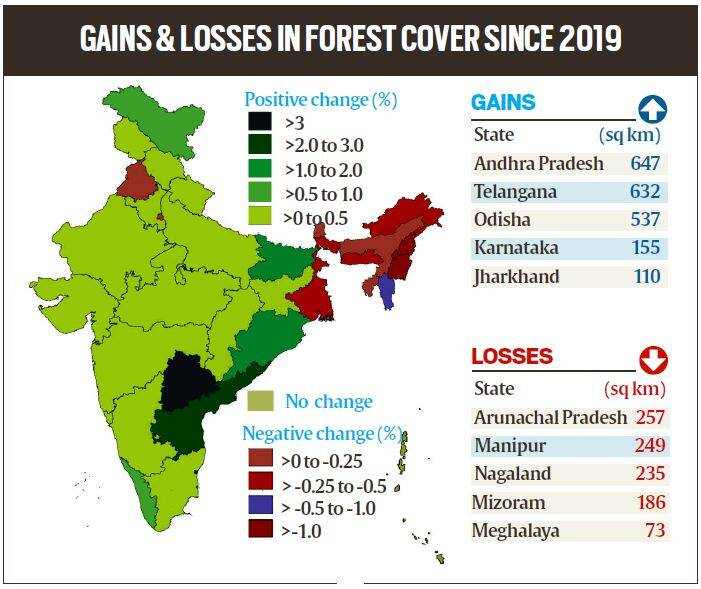Biodiversity & Environment
International Day of Forests
- 23 Mar 2022
- 7 min read
For Prelims: International Day of Forests, World Water Day, United Nations, Food and Agriculture Organisation, India’s State of Forest Report.
For Mains: Conservation, Issues Relating to Development, Forest Resources, State of India’s Forest and Related Initiatives.
Why in News?
Every year 21st March is celebrated as the International Day of Forests (IDF) by the United Nations (UN).
- It has to be noted that just a day after i:e 22nd March is celebrated as the World Water Day by the UN.
What is International Day of Forests?
- The UN proclaimed 21st March as the IDF in 2012 to celebrate and raise awareness of the importance of all types of forests.
- Countries are encouraged to undertake local, national and international efforts to organise activities involving forests and trees, such as tree planting campaigns.
- The organisers are the UN Forum on Forests and the Food and Agriculture Organisation (FAO) of the UN, in collaboration with Governments, the Collaborative Partnership on Forests and other relevant organisations in the field.
- The theme for 2022 is ‘Forests and sustainable production and consumption’.
What is the Significance of Forests?
- Forests cover one-third of the land surface on Earth and provide various environmental benefits, including their primary role in maintaining the balance of the hydrological cycle, contributing to climate regulation, and preserving biodiversity.
- Apart from the ecological perspective, studies from an economic perspective conclude that forest resources can contribute to a nation’s economic growth and maintaining forest cover is essential for various agricultural and forestry-related activities.
- Forests provide more than 86 million green jobs while supporting the livelihoods of many people.
- Everyone on the planet has had some form of contact with forests. This includes communities that directly rely on these ecosystems for their lives and livelihoods or communities which rely on the products obtained from these forests.
- Forest sustainable management and resource use are critical to preventing climate change and contributing to present and future generations' prosperity and well-being. Forests are also important for poverty alleviation.
- Despite these priceless environmental, economic, social, and health benefits, global deforestation continues at an alarming rate.
- The FAO has estimated that 10 million hectares were cleared each year globally between 2015 and 2020. Closer home, India lost 132kha of natural forest in 2020 alone, according to the Global Forest Watch, a worldwide platform that monitors forests and changing patterns.
- According to another study, Amazon Forests have started emitting Carbon dioxide (CO2) instead of absorbing it.
What is the State of Forests in India?
- The country has 3,07,120 square kilometres of forest in the open category, which increased by 4,203 sq km in the last two years (2019-21), according to India’s State of Forest Report 2021.
- Add scrub land (46,539 sq km) to this and the total becomes 3,53,659 sq km, constituting 10.76% of degraded forest and scrub land in India. If we consider only forest area, it is 43.03%.
- The report showed a continuing increase in forest cover across the country, but experts flagged some of its other aspects as causes for concern, such as a decline in forest cover in the Northeast, and a degradation of natural forests.
What are the Major Government Initiatives for Forests?
- National Mission for a Green India:
- It is one of the eight Missions under the National Action Plan on Climate Change (NAPCC).
- It was launched in February, 2014 with the objective to safeguard the biological resources of our nation and associated livelihoods against the peril of adverse climate change and to recognise the vital impact of forestry on ecological sustainability, biodiversity conservation and food-, water- and livelihood-security.
- National Afforestation Programme (NAP):
- It has been implemented since 2000 for the afforestation of degraded forest lands.
- It is being implemented by the Ministry of Environment, Forest and Climate Change (MoEFCC).
- Compensatory Afforestation Fund Management and Planning Authority, (CAMPA Funds):
- Launched in 2016, 90% of the fund is to be given to the states while 10% is to be retained by the Centre.
- The funds can be used for treatment of catchment areas, assisted natural generation, forest management, wildlife protection and management, relocation of villages from protected areas, managing human-wildlife conflicts, training and awareness generation, supply of wood saving devices and allied activities.
- National Action Programme to Combat Desertification:
- It was prepared in 2001 to address issues of increasing desertification and to take appropriate actions.
- It is implemented by the MoEFCC.
- Forest Fire Prevention & Management Scheme (FFPM):
- It is the only centrally funded program specifically dedicated to assist the states in dealing with forest fires.
UPSC Civil Services Examination, Previous Year Questions (PYQs)
Q. Consider the following States: (2019)
- Chhattisgarh
- Madhya Pradesh
- Maharashtra
- Odisha
With reference to the States mentioned above, in terms of percentage of forest cover to the total area of State, which one of the following is the correct ascending order?
(a) 2-3-1-4
(b) 2-3-4-1
(c) 3-2-4-1
(d) 3-2-1-4
Ans: (c)







